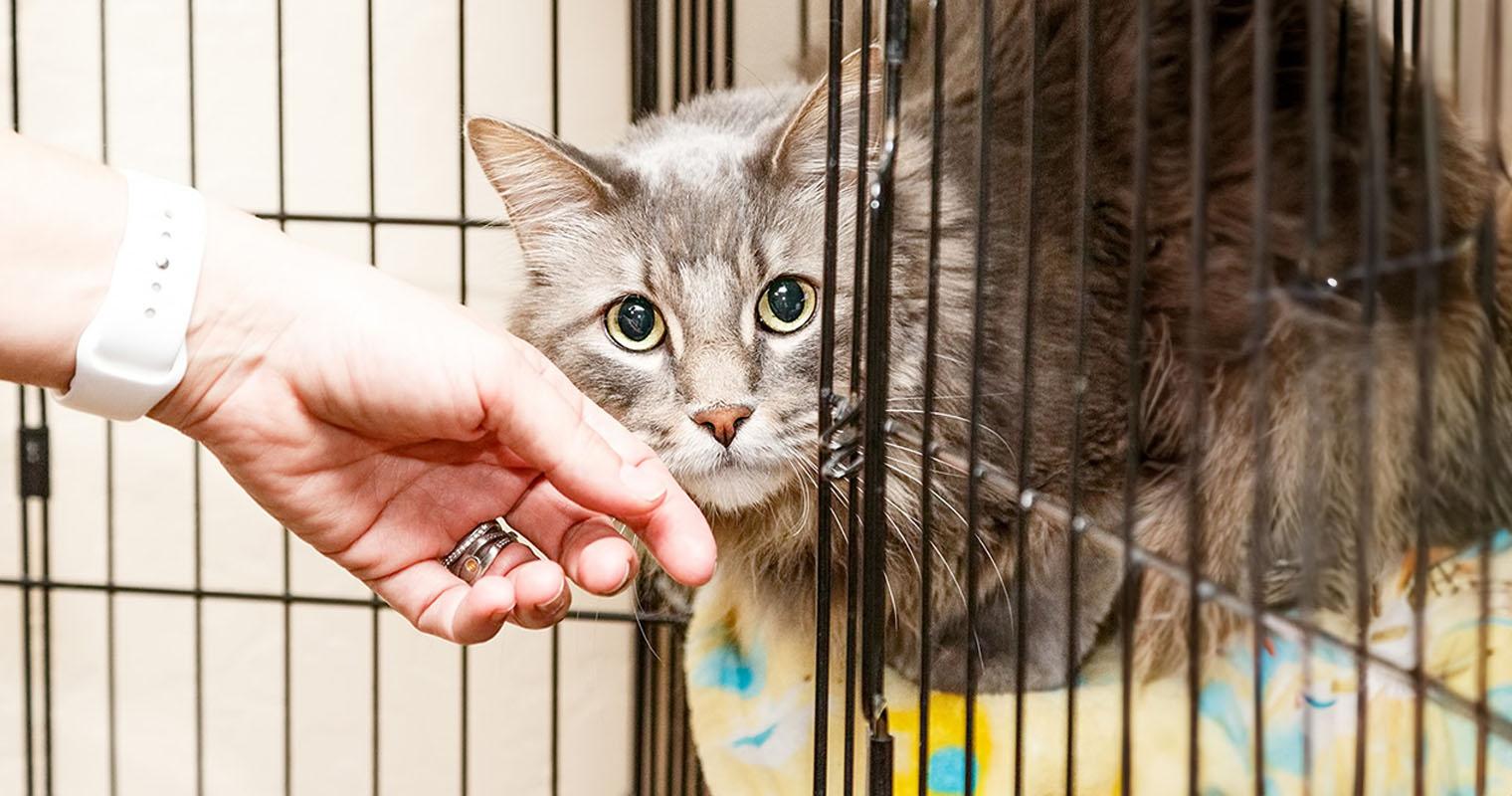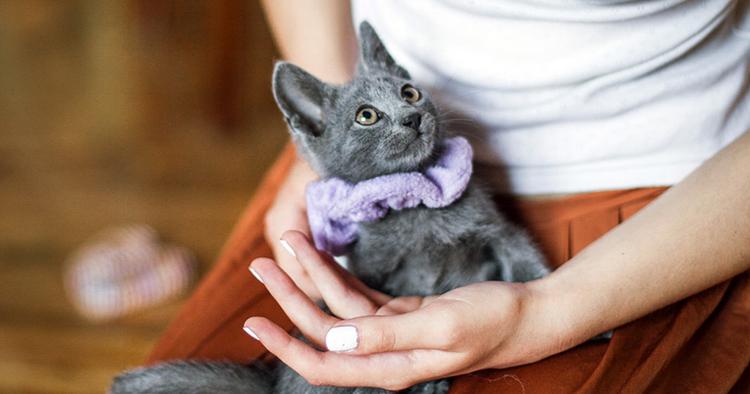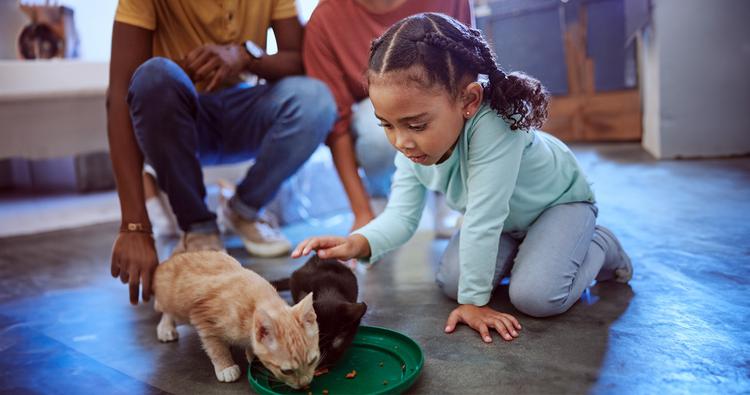10 Vital Questions to Ask When Adopting a Cat from a Shelter
Not every cat will be a match for you (and vice versa). Here’s how to find “the one.”
Not every cat will be a match for you (and vice versa). Here’s how to find “the one.”
by Katie Koschalk, | April 26, 2024

adogslifephoto / Adobe Stock
Just as not every person you encounter on Tinder will be your soulmate (and vice versa), not every cat you meet at the shelter will be the right match for you. So, when considering cat adoption, it’s crucial to ask the right questions about the cat’s history, health, and personality. The answers will help you determine if you are a mutual fit and can provide the care and environment the cat needs to thrive.
What should you ask the shelter staff before signing the adoption paperwork? Read on to find out.
Knowing if a cat was surrendered due to guardian circumstances, if they were found as a stray, or if they were transferred from another facility — all of the above can shed light on their temperament and potential adjustment period. For example, a cat with a history of living on the streets may require more time to acclimate to living inside a home.
A cat’s age significantly influences their care requirements and behavior. Kittens typically require more socialization, training, and monitoring than adult or senior cats. Understanding the cat’s age also allows you to anticipate their developmental stages, such as the playful-kitten phase or the calmer demeanor of a senior cat. This information helps you better prepare for the cat’s needs and adjust your expectations accordingly.
Common health issues in cats may require ongoing management. These include dental problems, feline immunodeficiency virus (FIV), diabetes, and kidney disease. It’s also important to know if the cat has any disabilities, such as blindness or deafness. By being aware of the cat’s health status upfront, you can determine if you have the resources to provide them with the care they need.
Each cat has a unique personality and temperament, which influences their compatibility with your lifestyle and household dynamics. Understanding a cat’s behavior traits, such as friendliness, playfulness, or shyness, helps you determine if they align with your preferences and expectations. For instance, an outgoing, social cat may thrive in a busy household with children, while a more reserved cat may prefer a quieter environment with fewer disturbances.
Litter-box training is essential for maintaining a clean, hygienic living environment for both you and your kitty. While many cats naturally gravitate toward their litter boxes, some may require a brief adjustment period. A smaller number of kittens may take several weeks to get the hang of it.
Certain cat breeds or coat types require more frequent grooming. For example, long-haired breeds such as Persians or Maine Coons have dense fur that’s prone to matting. Regular brushing helps prevent matting, reduces shedding, and promotes healthy coats and skin. Failure to groom long-haired cats properly can lead to discomfort, skin irritation, and even more severe issues like skin infections.
Knowing if the cat is highly active and playful or more laid-back and independent helps you choose a companion that matches your lifestyle and energy level. For example, an energetic cat may require frequent interactive play sessions, while a less active cat may prefer quiet cuddle time and gentle play.
Understanding the cat’s dietary needs (including preferred food brands, feeding schedule, portion sizes, and any dietary restrictions) allows you to determine if you can provide what the cat needs. For instance, a cat might require a prescription cat food that’s significantly more expensive than standard cat food.
Adoption fees vary by shelter, the services included (such as spaying/neutering, vaccinations, and microchipping), and sometimes the cat’s age. Knowing the adoption fee and what it includes helps you budget for the initial expenses of bringing a new cat into your home.
If you have other pets at home or plan to get more, it’s important to know if the cat has previous experience living with other animals. Understanding the cat’s socialization history and compatibility with other pets helps you anticipate potential challenges and plan for a smooth introduction process.
For example, a cat with positive experiences living with dogs or other cats may adapt well to a multi-pet household, while a cat with limited socialization will require gradual introductions and supervised interactions to prevent conflicts and stress. Sometimes a cat may not mesh with other animals at all, which could be a dealbreaker if you have other pets in your home.
Even if you’ve asked all the right questions, you never quite know how your new cat will act when you bring them home. Here are some tips to encourage the smoothest transition for you and your new companion.
It’s important to purchase all the necessary cat supplies before you bring your new kitty home. That way, you have everything ready to go upon their arrival. Here’s what you’ll need:
Cat carrier
Litter boxes and cat litter
Food and water bowls
Cat food and treats
Cat-safe toys
Cat bed
Grooming supplies
Cat-safe household cleaner
Expect that your new cat will investigate anything and everything in your home. To keep them (and your belongings) safe, it’s important to cat-proof your house. This means identifying and addressing potential hazards or areas of concern that could pose risks to your cat’s health and well-being. Here are some key steps to take:
Provide scratching posts: Prevent furniture damage by offering designated scratching posts and pads.
Secure cords and wires: Keep electrical cords and cables out of reach to prevent chewing.
Secure small items: Remove or put away small objects that your cat could swallow or choke on.
Move toxic plants out of reach: Some plants are poisonous to cats, so keep these out of your home or out of your cat’s reach.
Remove other toxic substances: Remove or secure items like household cleaners and medications that could be swallowed. Many cats are especially drawn to bleach.
Secure the perimeter: To prevent escapes, install secure screens on windows and doors, and make sure that outdoor enclosures or fencing are escape-proof.
Eliminating the smell of cat pee around your home can be incredibly challenging. That’s why it’s crucial to make your cat’s litter boxes as inviting as possible, so that they use it (and don’t go rogue). Here are some tips:
Provide enough litter boxes: You should have one litter box per cat, plus one extra. (So if you have two cats, you should provide three boxes.) This helps prevent territorial disputes and ensures everyone has access to a clean box.
Choose quiet locations: Cats prefer privacy when using the litter box, so place the boxes in quiet areas away from noisy appliances and high-traffic areas. And be sure they’re easily accessible to them.
Use the right litter: Most cats prefer unscented litter. Meanwhile, clumping litter makes scooping easier and more efficient for you.
Keep things clean: Scoop out your cat’s litter boxes at least twice a day. Replace the entire litter (and clean the litter box) every two to four weeks.
Be patient while training: If you have to litter-box train your new cat, don’t punish them for accidents. Instead, focus on positive reinforcement when they correctly use their boxes, and provide gentle redirection when they don’t.
Deciding between adopting an adult cat or a kitten depends on your lifestyle, personal preferences, and ability to meet their needs. Adult cats have established personalities and are generally calmer. Kittens offer bonding from a young age, but require more of your time and attention.
Adoption fees for a kitten or cat range from $100 to $500.
Ideally, you should schedule a vet visit within the first couple of weeks after adopting your cat. This appointment establishes care with a vet, evaluates your cat’s health, and provides any necessary vaccinations.
Mastering the Art of Litter Box Training: How to Train Cats to Use a Litter Box

Katie Koschalk is a freelance writer based in Northern California. Fusing her love and knowledge of animals with her journalism degree and years of professional writing, Katie is dedicated to improving the lives of pets and their caretakers by sharing helpful and accurate information. When she’s not at her desk, you can find her exploring trails with her Aussie, Hunter, cooking plant-based meals, and talking to her two cats, Jax and Sadie, in really ridiculous voices.

Adoption Advice

Adoption Advice

Adoption Advice

Adoption Advice
Here is why spaying or neutering your cat is important, and what to expect.

Adoption Advice
Stressed about raising your kitten? This guide has got you covered on everything you need to know to make sure your kitty is happy.

Adoption Advice
Are you ready to bring a new cat home? These tips will help you prep your kid for their new BFF.